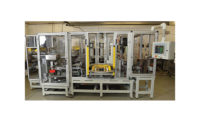Automotive Supplier Uses Screwdriving Spindle to Test Fuel Caps

Blau uses a computer-controlled electric screwdriving spindle to tighten and untighten fuel caps in an automated endurance testing cell. Photo courtesy DEPRAG

The E-SFM provides precise control over speed, torque, axial force and stroke—whether installing screws or tightening gas caps. Photo courtesy DEPRAG


How many times do you open and close the gas cap on your car? Once a week? Twice a week? More often? Over the life of a vehicle, you might fasten and unfasten the cap thousands of times.
Engineers at Blau, a subsidiary of Magna Energy Storage Systems GmbH in Weiz, Austria, have thought a lot about that. Blau assembles fuel tanks, fillers, and caps for fuel tanks and radiators. The company’s caps are known for their durability and tight fit. Combining various metal and plastic parts, the caps prevent unnecessary evaporation of fuel, which saves money and protects the environment.
To ensure the longevity of its fuel caps, Blau puts them through a variety of tests, including endurance testing. Engineers use a test cell to automatically tighten and untighten sample caps thousands of times to see how the materials hold up.
For such an application, an ordinary pneumatic rotary actuator will not do. The caps must be turned with consistent torque, speed, axial force and stroke length. To solve the problem, Blau turned to an unlikely source: screwdriving expert DEPRAG. Blau had been using the company’s screwdriving systems for years. So when Blau needed a rotary actuator that offered precise control over tightening and untightening, engineers approached DEPRAG to see if a screwdriving spindle could do the job.
DEPRAG supplied an electric screwdriving spindle with electronic stroke control (E-SFM). The E-SFM is designed to react flexibly to complex screwdriving tasks, new fasteners and changing assembly requirements. With appropriate adjustments to downforce, speed and position in the screwdriving application, cycle time is reduced and unnecessarily high stress on a component can be avoided. The costs of replacement wear parts are reduced due to precise, gentle engagement of the fastener.
“The E-SFM combines the flexibility of an electronic screwdriving tool with the flexibility of an electronic stroke unit, resulting in an outstanding versatile screwdriving system. This opens up new possibilities for solving technically challenging tasks,” explains Daniel Guttenberger, product manager for DEPRAG.
Adjustment to downforce, speed and position allows for a perfectly tuned screwdriving sequence: fast run to the screw head, gentle engagement, assembly with low downforce, final tightening with high downforce, measurement of fastener depth, and a fast return stroke after assembly. This is made possible by the accurate positioning and power regulation of the spindle during the screwdriving process.
The E-SFM Manager provides a user-friendly HMI so that parameters can be set and adjusted with accuracy. In comparison, with a pneumatic spindle, pressure must be reduced via a regulator. This is imprecise, and the adjustment range is limited. Another advantage of electronic control is gentle contact with the component. Damage to sensitive parts can be avoided, and the life of the bit can be extended.
The spindle can install fasteners from above or below, horizontal or at a specific angle. An integrated depth sensor allows engineers to precisely control fastener depth.
The E-SFM comes in three versions: one without automatic feeding; one with automatic feeding; and one with a vacuum pick-up. In Blau’s case, rather than a screwdriving bit, the spindle turns a custom fixture designed to hold the cap being testing.
On Blau’s test bench, the E-SFM is used in combination with the DEPRAG Compact Assembly Module. The fuel caps are tightened and untightened thousands of times on a test tank neck at a defined torque, angle and speed. The torque processes are accurately evaluated to check that the fuel cap continues to function perfectly after repeated opening and closing. During the rotary movements, the spindle must offset height variations defined by the fuel cap and the test tank neck, to ensure that rotations are unhindered.
For more information on screwdriving spindles, call 800-433-7724or visit www.depragusa.com.
Looking for a reprint of this article?
From high-res PDFs to custom plaques, order your copy today!








